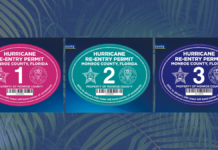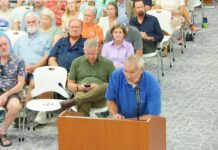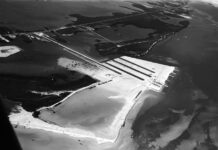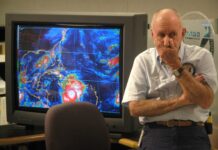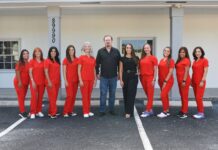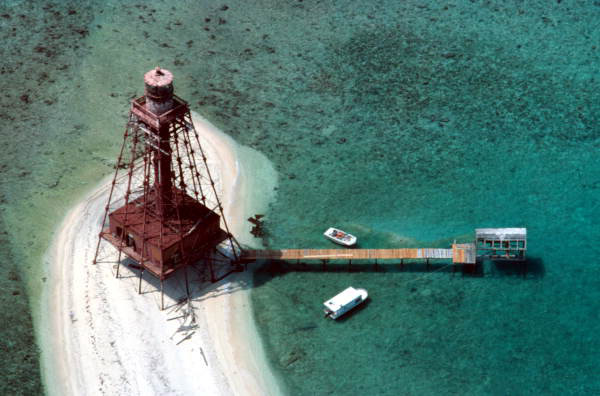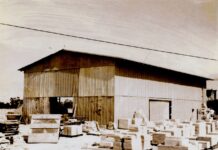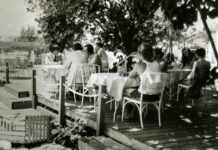The Havana Hurricane of 1846 is thought to be the first recorded Category 5 hurricane to strike Cuba. As the storm crossed the Straits of Florida, it ravaged the Florida Keys, too.
It is considered to be one of the most powerful hurricanes to strike Key West. The brick fortification Fort Zachary Taylor suffered tremendous damage. The Custom House and Marine Hospital were unroofed. The island’s wharves were either damaged or washed away. Of the island’s 600 homes, only six escaped the storm’s destructive forces. The rest were unroofed or flattened.
The storm demolished the Key West Lighthouse and the keeper’s quarters, and a sand beach washed up in their place. As the storm surge washed over the island, the flood caused a reported current of 6 miles per hour to run through the streets. A few miles southwest, the Sand Key Lighthouse and its keeper’s quarters were completely washed away, as was the small spit of land where the 70-foot conical brick tower had been built.
The following year, Congress allocated $30,000 for a lighthouse at Carysfort Reef, $12,000 to replace the lighthouse at Key West, and $20,000 to build a screw-pile lighthouse at Sand Key. The $20,000 for the Sand Key light would represent a down payment.
In the wake of the storm, the 140-ton ship, “Honey,” was refitted with lanterns fixed to its masts so that it could be moored near Sand Key and serve as a temporary lightship. According to the Key West insurance underwriter John C. Hoyt, the “Honey” did not do its job well. In 1850, he wrote, “The light-ship stationed near Sand Key is old and the light is miserable. Several vessels and much valuable cargo have been lost by the neglect of the government to build a lighthouse at Sand Key.”
The following year, an additional $39,970.74 was appropriated for the Sand Key Lighthouse project. Having finished supervising the construction of the Carysfort Reef Lighthouse in 1852, Lt. George G. Meade of the Army Corps of Topographical Engineers was assigned to the Sand Key project. For Civil War buffs, the name George Meade might have a familiar ring to it. During the war, the now General George G. Meade served the Union efforts and commanded the Army of the Potomac that helped defeat Robert E. Lee at the battle (the second battle) of Gettysburg.
To complete the lighthouse, an additional $44,127.81 was allocated to the project. The Sand Key Lighthouse, like the light at Carysfort Reef, was of a screw-pile design. Unlike the light at Carysfort Reef, the Sand Key light was structured on a pyramidal framework. When it was finished, the lighthouse stood 132 feet high and had a focal plane of 109 feet. The focal plane was the distance between the center of the lighthouse’s powerful lens and the Atlantic’s mean tide. The light first flashed over the reef on July 20, 1853.
The lighthouse keeper was paid $550 per year plus one ration per day. Assistant keepers were paid $300 per year and the same daily ration. Their job was isolated and lonely. Keeping the lamp filled with oil and the wick viable was important work, one that made a difference. The dangerous Straits of Florida, bordered by the Great Bahama Bank on one side and the unforgiving corals of the Florida Reef on the other, had seen the peril of hundreds and hundreds of ships and the loss of untold amounts of cargo.
On Dec. 3, 1855, the following appeared in the Bangor Daily Whig and Courier: “Since the erection of the celebrated Carysfort and Sand Key Iron Lighthouses and the establishment of the Coast Survey of a chain of beacons along the whole extent of the reef, the falling off in the wrecking business has been very great. In 1846 and 1847, over forty vessels were engaged wholly in saving lives and property upon this coast. At the present time, there are but twenty regularly employed and this number will soon be reduced, the business being too uncertain and the salvage decreased where service is rendered too inadequate. Since, then, wreckers are falling and wrecks becoming rare, rates of insurance must be reduced to correspond more equally with the risks incurred.”
The government worked to continue building a series of lighthouses marking the Florida Reef until there were a total of six. Sombrero Key Lighthouse would first be lit in 1858, Alligator Reef Lighthouse in 1873, Fowey Rocks Lighthouse in 1878, and American Shoal Lighthouse in 1880.
By the turn of the century, the wrecking industry was gasping its last breaths.

